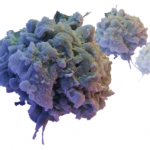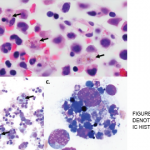appropriate testing and imaging tests. When there is a strong suspicion for malignancy, it may be appropriate to consider PET scanning. A marked elevation in the ratio of sIL-2R to ferritin may suggest the presence of lymphoma-associated HLH rather than HLH related to benign disease.
 Anita Laloo, MB, BS, MPH, is a recent graduate of the Beth Israel Deaconess Medical Center Rheumatology Fellowship in Boston.
Anita Laloo, MB, BS, MPH, is a recent graduate of the Beth Israel Deaconess Medical Center Rheumatology Fellowship in Boston.
German Pihan, MD, is the chief of Diagnostic Hematopathology Service and director of the Hematopathology Fellowship Training Program at Beth Israel Deaconess Medical Center in Boston.
 Robert H. Shmerling, MD, is the clinical chief of Rheumatology and Robinson Firm Chief at Beth Israel Deaconess Medical Center in Boston and a senior editor at Harvard Health Publications.
Robert H. Shmerling, MD, is the clinical chief of Rheumatology and Robinson Firm Chief at Beth Israel Deaconess Medical Center in Boston and a senior editor at Harvard Health Publications.
References
- Otrock ZK, Eby CS. Clinical characteristics, prognostic factors, and outcomes of adult patients with hemophagocytic lymphohistiocytosis. Am J Hematol. 2015 Mar;90(3):220–224.
- Jordan MB, Allen CE, Weitzman S, et al. How I treat hemophagocytic lymphohistiocytosis. Blood. 2011 Oct 13;118(15):4041–4052.
- Henter JI, Horne A, Arico M, et al. HLH-2004: Diagnostic and therapeutic guidelines for hemophagocytic lymphohistiocytosis. Pediatr Blood Cancer. 2007 Feb;48(2):124–131.
- Yamaguchi M, Ohta A, Tsunematsu T, et al. Preliminary criteria for classification of adult Still’s disease. J Rheumatol. 1992 Mar;19(3):424.
- Miyahara M, Sano M, Shibata K, et al. B-cell lymphoma-associated hemophagocytic syndrome: Clinicopathological characteristics. Ann Hematol. 2000 Jul;79(7):378.
- Chang TY, Jaffray J, Woda B, et al. Hemophagocytic lymphohistiocytosis with MUNC13-4 gene mutation or reduced natural killer cell function prior to onset of childhood leukemia. Pediatr Blood Cancer. 2011 May;56(5):856–858.
- Tsuji T, Hirano T, Yamasaki H, et al. A high sIL-2R/ferritin ratio is a useful marker for the diagnosis of lymphoma-associated hemophagocytic syndrome. Ann Hematol. 2014 May;93(5):821–826.
- Rivière S, Galicier L, Coppo P, et al. Reactive hemophagocytic syndrome in adults: A retrospective analysis of 162 patients. Am J Med. 2014 Nov;127(11):1118.
- Tothova Z, Berliner N. Hemophagocytic syndrome and critical illness: New insights into diagnosis and management. J Intensive Care Med. 2015 Oct;30(7):401–412.
- Trottestam H, Horne A, Aricò M, et al. Chemoimmunotherapy for hemophagocytic lymphohistiocytosis: long-term results of the HLH-94 treatment protocol. Blood. 2011 Oct 27;118(17):4577–4584.


